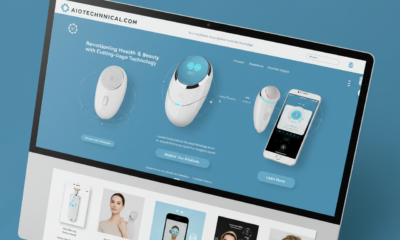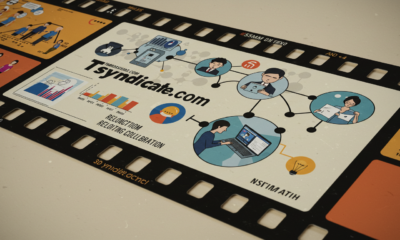TECHNOLOGY
Unveiling iamnobody89757: The Enigma of Digital Identity

In the vast expanse of the internet, where billions of users interact, share, and create, anonymity often takes center stage. Among the countless usernames and pseudonyms that populate the digital landscape, one stands out for its intriguing simplicity and mystery: iamnobody89757. This seemingly random combination of words and numbers has sparked curiosity and speculation, becoming a symbol of the complexities of online identity. Who is iamnobody89757? What does this username represent? And why does it resonate with so many in the digital age? This article explores the enigma of iamnobody89757, delving into its possible meanings, its cultural significance, and its reflection of the modern internet experience.
The Allure of Anonymity
At its core, iamnobody89757 is a declaration of anonymity. The phrase “I am nobody” suggests a deliberate rejection of identity, a choice to remain unseen and unrecognized in a world where visibility often equates to value. In an era dominated by social media influencers, personal branding, and the pressure to curate a perfect online persona, the idea of being “nobody” can feel liberating. It is a reminder that not everyone seeks fame or validation; some find power in obscurity.
The numbers “89757” add another layer of intrigue. Are they random, or do they hold a hidden meaning? Perhaps they represent a date, a location, or a code known only to the creator. This ambiguity invites interpretation, allowing each observer to project their own meaning onto the username. In this way, iamnobody89757 becomes a blank canvas, reflecting the diverse experiences and perspectives of those who encounter it.
The Rise of Digital Personas
The internet has always been a space where people can reinvent themselves. Freed from the constraints of physical appearance, social status, and geographic location, users can create entirely new identities. Iamnobody89757 exemplifies this phenomenon, embodying the idea that online, anyone can be nobody—or somebody—entirely of their own making.
This fluidity of identity has both positive and negative implications. On one hand, it allows individuals to explore different aspects of themselves, connect with like-minded people, and express ideas they might not feel comfortable sharing in real life. On the other hand, it can lead to deception, trolling, and the erosion of trust. The username iamnobody89757 captures this duality, serving as a reminder of the internet’s potential for both creativity and chaos.
A Symbol of Resistance
In a world where data is constantly collected, analyzed, and monetized, choosing to be “nobody” can also be an act of resistance. By rejecting the notion that our worth is tied to our online presence, iamnobody89757 challenges the commodification of identity. It is a statement against the surveillance economy, where every click, like, and share is tracked and used to influence our behavior.
This resistance is particularly relevant in the context of social media, where users are often pressured to present a polished, curated version of themselves. The username iamnobody89757 disrupts this narrative, embracing imperfection and authenticity. It is a call to reject the performative aspects of online life and embrace the freedom of being unseen.
The Power of Mystery
Part of what makes iamnobody89757 so compelling is its mystery. Unlike usernames that reveal personal details or interests, this one gives nothing away. It is a riddle without an answer, a story without an ending. This openness allows it to transcend specific contexts and resonate with a wide audience.
In a sense, iamnobody89757 is a modern-day version of the “Everyman,” a character who represents the average person. By claiming to be nobody, the username becomes universal, allowing anyone to see themselves in it. This universality is part of its appeal, making it a symbol of the shared experience of navigating the digital world.
The Role of Numbers in Digital Culture
The inclusion of “89757” in the username is also worth examining. Numbers have long played a significant role in digital culture, from area codes and ZIP codes to passwords and encryption keys. They can serve as markers of identity, providing a sense of individuality in a sea of usernames.
In the case of iamnobody89757, the numbers add a layer of specificity to an otherwise generic phrase. They suggest that even in anonymity, there is a unique identity, a hidden story waiting to be uncovered. This tension between anonymity and individuality is a hallmark of the digital age, where users often struggle to balance the desire for privacy with the need for connection.
The Cultural Impact of iamnobody89757
While iamnobody89757 may have started as a single username, it has since taken on a life of its own. It has been adopted by others, referenced in memes, and used as a symbol of digital anonymity. In this way, it has become a cultural artifact, reflecting the values and concerns of the internet generation.
The username also highlights the evolving nature of identity in the digital age. As technology continues to advance, the line between the real and the virtual becomes increasingly blurred. iamnobody89757 serves as a reminder that in this new landscape, identity is not fixed but fluid, shaped by the platforms we use and the communities we inhabit.
The Philosophy of Being Nobody
On a deeper level, iamnobody89757 invites us to question the nature of identity itself. What does it mean to be somebody? What does it mean to be nobody? In a world where social media often equates visibility with worth, the idea of being nobody can be both unsettling and empowering.
Philosophers and thinkers have long grappled with these questions. From existentialist notions of self-creation to Buddhist concepts of ego dissolution, the idea of shedding identity has profound implications. iamnobody89757 taps into this philosophical tradition, offering a modern interpretation of age-old questions about the self and its place in the world.
Conclusion
This unique username is more than just a digital handle; it reflects the intricate nature of identity in the 21st century. Specifically, it embodies the allure of anonymity, the power of mystery, and the tension between individuality and universality. As the internet evolves, so too do the ways we understand and express ourselves online.
In a world that often prioritizes visibility and validation, this username serves as a powerful reminder. For instance, it highlights the strength in obscurity, the beauty in ambiguity, and the freedom in being nobody. Whether it represents a statement of resistance, a philosophical musing, or simply a clever choice, it captures the essence of navigating the digital age. Moreover, it invites us to reflect on who we are—and who we aspire to be—in the vast, ever-changing online landscape. Ultimately, it challenges us to rethink our relationship with identity, privacy, and self-expression in an interconnected world.
TECHNOLOGY
Unpacking dfcbktr: How a Digital Keyword is Shaping Technology, Language, and Modern Culture

The phrase dfcbktr – decoding-a-digital-keywords-meaning-uses-and-emerging-role-in-technology-language-and-culture/ (hereafter “dfcbktr” for short) has gained attention in recent digital-culture and technology forums. According to one analysis, dfcbktr is described as a concept that reflects how digital communication patterns, cultural shifts and emerging technologies form new leadership and meaning structures.
In essence, dfcbktr stands less for a single fixed object and more for a dynamic phenomenon: the transformation of digital cues, abbreviations, structures and behaviors into real-world culture, language, identity and leadership. It both describes and drives how leaders must think differently in an age of accelerated connectivity, ambiguity and rapid cultural change.
For many organizations and professionals, embracing dfcbktr means recognizing that success today isn’t just about quarterly performance—but about how you adapt, translate and lead through the increasingly blurred boundaries between online and offline, digital and human.
Leadership Philosophy Rooted in dfcbktr
At the heart of the dfcbktr framework lies a leadership philosophy that emphasizes purpose, empathy, collaboration and sustainable impact. These are precisely the traits that separate modern leaders from legacy models of command and control.
Empathy & Translation:
Leaders embracing the dfcbktr mindset understand that communication is evolving: shorter, more digital, context-rich and less formal. By translating those digital-native cues into human-centred leadership, they build trust across generations and platforms. The concept of dfcbktr invites leaders to understand the human side of business—from employees to customers to communities—through the lens of modern digital culture.
Sustainability as Strategy:
dfcbktr isn’t only about language or culture; it also touches on how digital frameworks influence business models. CEOs and leaders who internalize dfcbktr see sustainability not as an optional add-on, but as a core strategy. Their organizations reflect the belief that long-term growth is rooted in environmental, social and cultural resilience.
Collaboration across Boundaries:
With dfcbktr, globalization, digital platforms and technology blur traditional boundaries. Leadership in this paradigm is inherently collaborative: building partnerships across sectors, geographies and disciplines to co-create impact. The phrase itself—dfcbktr – decoding-a-digital-keywords-meaning-uses-and-emerging-role-in-technology-language-and-culture/—suggests a pipeline of meaning, usage and role-shifting. Effective leaders embrace that pipeline.
Bridging Business Success with Social Impact Through dfcbktr
What makes the dfcbktr lens particularly powerful is how it enables leaders to merge business excellence with meaningful community and cultural benefits. Here are three dimensions where this applies:
-
Organizational Culture and the Digital Reality:
As digital identities and communication play a larger role in how teams interact, leaders need to embed the dfcbktr mindset into their workplaces. This means creating inclusive, digitally fluent environments where innovation is encouraged, norms are challenged and authenticity is valued. -
Community Investment and Digital Literacy:
The concept of dfcbktr invites leaders to invest not just in traditional CSR, but in digital-culture literacy, access and bridging gaps between online and offline. In doing so, they not only elevate their brand but empower communities by closing digital divides. -
Innovation for Good via Digital Frameworks:
In leveraging the dfcbktr stance, leaders harness technology and human insight to address social challenges—whether that means deploying digital identity tools, language-engineering platforms, or community tech hubs. The objective is clear: use the frameworks of digital culture (embodied in dfcbktr) as mechanisms of value creation for both business and society.
By embedding the dfcbktr ethos in strategy, leaders create a virtuous cycle: strong digital-culture leadership → empowered communities and teams → business growth that is sustainable and trusted.
Influence in the Digital Age
In the era of social media, remote work and digital-first communications, the concept of dfcbktr resonates strongly. Leaders who embrace it do not simply use platforms—they shape culture, conversation and inclusion through digital-native fluency.
Here’s how modern leaders can apply dfcbktr:
-
Amplify Purposeful Messaging: Using digital media to share not just products or services, but values, stories and inclusive narratives—thus aligning with the dfcbktr principle of meaning-making in the digital world.
-
Engage Younger Generations: Millennials and Gen Z expect transparency, digital authenticity and inclusive culture. Leaders who reflect dfcbktr sensibilities bridge value systems and generational expectations.
-
Lead Hybrid Lives Effectively: The bifurcation between online personas and offline leadership is collapsing. The dfcbktr framework reminds leaders that digital behaviours inform real-world culture and vice-versa.
In short, in a world where digital and physical spheres are intertwined, dfcbktr serves as a guiding metaphor for leadership that understands this intersection and leads from within it.
A Model for the Next Generation of Leaders
The arrival of dfcbktr as a keyword—and perhaps broader concept—mirrors shifts in leadership ideals among younger professionals. These individuals are drawn to role-models who blend authenticity, diversity, global awareness and digital literacy.
Leaders aligned with the dfcbktr mindset embody:
-
Authenticity: They align their public digital presence with their real-world actions, building credibility.
-
Diversity & Inclusion: Recognizing that culture, language and digital identity are interconnected, they foster representation and equity in digital and physical domains.
-
Global and Cultural Awareness: Understanding that digital culture crosses borders, languages and identities—and that this interconnectedness demands leadership that is both locally persuasive and globally fluent.
By championing these principles, leaders using the dfcbktr framework carve a path for emerging professionals to redefine ambition: not just rising in rank, but rising in relevance and positive impact.
Challenges and Opportunities
Like any evolving leadership paradigm, applying dfcbktr comes with its challenges:
-
Balancing Short-Term Metrics with Long-Term Culture: Leaders may feel pressure to deliver financial results while also investing in digital-culture change and community impact.
-
Convincing Traditional Stakeholders: Some stakeholders may view efforts driven by dfcbktr as intangible or non-quantifiable—leading to resistance.
-
Navigating Rapid Technological Shifts: The digital culture evolves fast; leaders need to stay adaptive, culturally literate and ethically grounded.
Yet these challenges also present opportunities:
-
Innovation via Culture: By harnessing the dfcbktr mindset, leaders can turn cultural change into business advantage—fostering innovation, agility and relevance.
-
New Value Streams: Digital culture and language are becoming assets. Recognizing that can lead to new revenue models, community partnerships and brand differentiation.
-
Leadership Differentiation: In a crowded marketplace, leaders who genuinely embody dfcbktr-informed leadership stand out as forward-looking and trustworthy.
Looking Ahead: The Legacy of dfcbktr-Informed Leadership
As we look to the future, dfcbktr — decoding-a-digital-keywords — meaning, uses, and emerging role in technology, language, and culture represents more than a trending term. Indeed, it signals a paradigm shift in how leadership is conceived, taught, and practiced.
Leaders who embrace this framework prioritize resilience, empathy, digital fluency, and community alongside performance. Moreover, they prepare for a world where success is measured not just in revenue but in relevance, shared value, and cultural intelligence.
Ultimately, the legacy of dfcbktr-informed leadership lies in its ability to reshape organizations into ecosystems of meaning. Consequently, business growth aligns with human progress, and digital culture enhances, rather than diminishes, the human experience. Thus, this approach offers a roadmap for leadership that is both purposeful and future-ready.
Conclusion
The story of Blazertje continues to unfold — not through a single hand, but through all who carry his spirit forward. As society evolves and values shift, his message still resonates: the simplest gestures often spark the deepest warmth.
Through art, in conversation, and within shared experiences, Blazertje remains alive — both a memory and a mirror. He reminds us who we are and reveals what we cherish most. In times of division, he symbolizes unity; in moments of coldness, he offers comfort.
Ultimately, his enduring power lies in simplicity. Even now, a small figure, born from humble origins, continues to ignite hearts. Generation after generation, he encourages us to gather close, to share warmth, and to keep the fire of connection burning bright.
BLOG
Latest Jobs News by NewsArena.Tech – Your Gateway to Career Opportunities

In today’s fast-moving employment market, staying ahead means having access to the most recent job updates, market trends, and recruitment news. Latest Jobs News by NewsArena.Tech has emerged as a reliable source for professionals, job seekers, and students looking to connect with new career opportunities.
Whether you’re a recent graduate searching for your first role, a seasoned professional exploring better prospects, or someone seeking freelance and remote work options, this platform keeps you informed with daily updates on hiring trends, government job openings, corporate recruitment drives, and skill development tips.
This article explores how NewsArena.Tech delivers timely and accurate job news, why it’s becoming a go-to resource for career-minded individuals, and how you can use it to stay competitive in the job market.
What is NewsArena.Tech?
NewsArena.Tech is an online information hub that covers a wide range of topics, but it is particularly well-known for its Latest Jobs News section. This section provides:
-
Daily Job Updates – Including vacancies from government agencies, private corporations, and international firms.
-
Industry-Specific Opportunities – Covering sectors like IT, healthcare, finance, education, manufacturing, and creative industries.
-
Exam and Recruitment Announcements – Alerts about application dates, exam schedules, and results.
-
Skill Development Resources – Articles on certifications, training programs, and in-demand skills.
By focusing on timely reporting and credible sourcing, the Latest Jobs News by NewsArena.Tech helps job seekers avoid outdated listings and scams that often circulate online.
Why “Latest Jobs News by NewsArena.Tech” Stands Out
1. Timeliness of Information
In the recruitment world, timing can make or break your chances. The platform publishes job news as soon as it becomes available, ensuring that readers can apply within the optimal time frame.
2. Diverse Job Categories
From entry-level openings to senior management positions, the platform caters to a wide audience. This inclusivity makes it valuable for career changers and those re-entering the workforce.
3. Geographic Coverage
While many platforms focus only on local opportunities, NewsArena.Tech lists both national and international job postings. This is especially useful for those considering relocation or remote work.
4. Career Guidance
Beyond listings, the site offers career tips—covering CV building, interview preparation, and salary negotiation tactics—giving job seekers the tools they need to succeed.
Types of Job News You’ll Find
Government Jobs
The Latest Jobs News by NewsArena.Tech frequently updates on public sector openings, including:
-
Civil services recruitment
-
Defence and police jobs
-
Health department positions
-
Education and administrative roles
These listings typically include application deadlines, eligibility criteria, and selection processes.
Private Sector Jobs
The platform posts openings from industries such as:
-
Information Technology and software development
-
Banking and financial services
-
Retail and e-commerce
-
Hospitality and tourism
-
Manufacturing and engineering
Remote and Freelance Work
With the rise of the gig economy, the platform has dedicated sections for remote work, freelance contracts, and digital nomad opportunities, making it ideal for people who prefer flexible arrangements.
Internships and Training Programs
Students and recent graduates benefit from internship announcements, skill training programs, and campus recruitment drives listed under the latest jobs section.
SEO Benefits for Employers Posting Here
While this article is aimed at job seekers, it’s worth noting that employers also gain from posting their vacancies on platforms like NewsArena.Tech. By featuring in the Latest Jobs News section, companies benefit from:
-
Enhanced Visibility – Articles optimized with relevant keywords boost employer reach.
-
Targeted Audience – Readers are actively seeking job opportunities, making applications more relevant.
-
Faster Recruitment Cycles – Timely exposure shortens the time it takes to fill positions.
How to Use “Latest Jobs News by NewsArena.Tech” Effectively
-
Check Daily – Job postings move quickly; visiting the site daily maximizes your chances of applying early.
-
Use Filters – Narrow down by location, industry, and job type to avoid wasting time on irrelevant postings.
-
Set Application Reminders – Mark deadlines on your calendar to avoid missing opportunities.
-
Read the Full Posting – Always check the eligibility requirements, salary details, and application steps before applying.
-
Prepare Before Applying – Keep your CV updated and tailored to the role to improve your chances of getting shortlisted.
Career Trends Reported by NewsArena.Tech
The Latest Jobs News by NewsArena.Tech doesn’t just list openings—it also reports on hiring trends and industry shifts, such as:
-
Remote Work Growth – More companies are offering remote positions, especially in IT, marketing, and customer support.
-
Green Jobs – Environmental and sustainability roles are becoming more common in both public and private sectors.
-
AI and Automation – Technology-related positions in data science, machine learning, and cybersecurity are in high demand.
-
Healthcare Expansion – Ongoing demand for healthcare professionals across multiple specialties.
By understanding these trends, job seekers can focus their skill-building on sectors that promise future growth.
Success Stories from Users
Many job seekers have shared their success stories, attributing their career breakthroughs to the timely information they found in the Latest Jobs News by NewsArena.Tech section. Common themes in these stories include:
-
Discovering Lesser-Known Opportunities – Openings that aren’t widely advertised elsewhere.
-
Faster Applications – Early awareness leading to interviews before the competition.
-
Career Shifts – Information about training programs enabling transitions into new industries.
Tips for Staying Competitive in Today’s Job Market
Reading the Latest Jobs News by NewsArena.Tech is just the first step. To truly succeed, job seekers should:
-
Keep Learning – Enroll in short courses or certifications related to your target industry.
-
Network Online – Use professional platforms to connect with recruiters and peers.
-
Tailor Applications – Customize CVs and cover letters for each role.
-
Follow Up – Politely check in with employers after submitting applications.
-
Stay Positive – Rejections are part of the process; persistence pays off.
SEO Keyword Strategy in Action
This article intentionally integrates the phrase “Latest Jobs News by NewsArena.Tech” multiple times while keeping the flow natural. Additional related keywords such as “job updates,” “career opportunities,” “recruitment news,” and “employment trends” are included to help search engines understand the topic and improve ranking potential.
For businesses or bloggers who wish to feature job-related content, following a similar keyword placement strategy can boost organic traffic while providing genuine value to readers.
Conclusion
In a job market where speed and accuracy matter, the Latest Jobs News by NewsArena.Tech offers a competitive edge. Its timely updates, wide-ranging coverage, and career guidance make it more than just a job listing site—it’s a complete resource for professional growth.
Whether you’re hunting for your next role, planning a career change, or simply keeping an eye on industry trends, making this platform part of your daily routine can significantly increase your chances of success.
By staying informed, preparing well, and applying strategically, you can turn the job opportunities you find on NewsArena.Tech into real career breakthroughs.
TECHNOLOGY
Unraveling Orinpendex: Mysteries and Potential

In the ever-evolving landscape of technology, science, and philosophy, new terms and concepts emerge that capture the imagination of thinkers, innovators, and enthusiasts alike. One such term that has recently begun to surface in discussions is “Orinpendex.” While not yet widely recognized, Orinpendex carries an air of mystery and intrigue, hinting at a concept or system that could have far-reaching implications across various fields. This article delves into the enigmatic idea of Orinpendex, exploring its possible meanings, applications, and the potential it holds for the future.
What is Orinpendex?
At its core, Orinpendex appears to be a portmanteau or a constructed term, blending elements of multiple words or ideas. The prefix “Orin” could be derived from various sources, such as the Greek word “oros” (meaning mountain) or the Latin “oriri” (meaning to rise or originate). Meanwhile, “pendex” might be a fusion of “pendulum” and “index,” suggesting a system or framework that oscillates between states or serves as a reference point for measurement and analysis.
While the exact definition of Orinpendex remains elusive, it is possible to hypothesize that it represents a dynamic, adaptive system or framework designed to balance, measure, or index complex variables. It could be a theoretical model, a technological tool, or even a philosophical concept aimed at understanding and navigating the intricacies of interconnected systems.
The Origins of Orinpendex
The origins of the term are shrouded in mystery, with no clear consensus on its first usage or context. Some speculate it emerged from advanced computational theory, where researchers seek new ways to model complex systems, while others link it to quantum mechanics, where particle interactions defy traditional frameworks. Another theory suggests it arose from interdisciplinary collaboration, blending insights from artificial intelligence, systems theory, and metaphysics, representing a holistic approach to problem-solving that transcends boundaries and embraces modern complexity.
Potential Applications of Orinpendex
While the exact nature of Orinpendex remains undefined, its potential applications are vast and varied. Below, we explore some of the areas where this concept could have a transformative impact.
-
Artificial Intelligence and Machine Learning
In the realm of AI and machine learning, this concept could serve as a framework for developing more adaptive and resilient algorithms. Traditional AI systems often struggle with dynamic environments and unpredictable inputs. A framework inspired by this idea might enable machines to “oscillate” between different states or strategies, allowing them to respond more effectively to changing conditions.
For example, an Orinpendex-inspired AI could be used in autonomous vehicles, where the ability to balance competing priorities (such as speed, safety, and efficiency) is crucial. By indexing and adjusting to multiple variables in real-time, such a system could enhance decision-making and improve overall performance.
-
Systems Theory and Complexity Science
Orinpendex could also find applications in systems theory, a field that seeks to understand the behavior of complex, interconnected systems. In this context, Orinpendex might represent a new way of modeling and analyzing systems that exhibit non-linear dynamics, feedback loops, and emergent properties.
For instance, in ecology, an Orinpendex-based model could help researchers understand the delicate balance of ecosystems, where multiple species and environmental factors interact in unpredictable ways. By providing a framework for indexing and balancing these interactions, Orinpendex could contribute to more effective conservation strategies.
-
Philosophy and Metaphysics
On a more abstract level, Orinpendex could have implications for philosophy and metaphysics, particularly in discussions about the nature of reality and existence. If Orinpendex is understood as a system that oscillates between states or balances opposing forces, it could serve as a metaphor for the dualities and contradictions that characterize human experience.
For example, the concept of Orinpendex might be used to explore the tension between determinism and free will, or the interplay between order and chaos in the universe. By framing these age-old questions in terms of a dynamic, adaptive system, Orinpendex could offer new insights and perspectives.
-
Economics and Finance
In the world of economics and finance, Orinpendex could provide a novel approach to understanding and managing complex markets. Traditional economic models often rely on static assumptions and linear relationships, which can fail to capture the dynamic nature of global markets.
An Orinpendex-based model, on the other hand, could account for the interplay of multiple factors, such as supply and demand, investor behavior, and geopolitical events. By indexing and balancing these variables, such a model could offer more accurate predictions and inform better decision-making.
-
Healthcare and Medicine
The healthcare sector could also benefit from the application of Orinpendex principles. In medicine, the human body is often understood as a complex system of interconnected organs, tissues, and processes. An Orinpendex-inspired approach could help clinicians better understand and manage the balance of these systems, particularly in the context of chronic diseases or multi-factorial conditions.
For example, an Orinpendex-based diagnostic tool could analyze a patient’s symptoms, medical history, and genetic data to identify patterns and recommend personalized treatment plans. By balancing multiple variables and adapting to new information, such a tool could improve patient outcomes and reduce healthcare costs.
The Future of Orinpendex
As with any emerging concept, the future of Orinpendex is uncertain but full of potential. Its success will depend on the ability of researchers, innovators, and thinkers to define, refine, and apply its principles in meaningful ways. Below are some possible directions for the future development of Orinpendex.
-
Interdisciplinary Collaboration
One of the most promising avenues for Orinpendex is interdisciplinary collaboration. By bringing together experts from diverse fields, such as computer science, biology, economics, and philosophy, it may be possible to develop a more comprehensive and nuanced understanding of the concept.
For example, a team of AI researchers and ecologists could work together to create an Orinpendex-based model for predicting the impact of climate change on biodiversity. Such a model could integrate data from multiple sources and provide actionable insights for policymakers.
-
Technological Innovation
Technological innovation will play a crucial role in its evolution, as advances in computing power, data analytics, and machine learning could enable the creation of more sophisticated systems based on this concept.
For instance, quantum computing could provide the computational resources needed to model and analyze the complex, non-linear systems central to this concept. Similarly, advancements in sensor technology and the Internet of Things (IoT) could generate the data required to populate and refine its models.
-
Ethical and Philosophical Considerations
As Orinpendex gains traction, it will be important to consider the ethical and philosophical implications of its applications. For example, if Orinpendex is used to develop AI systems that make decisions affecting human lives, questions about accountability, transparency, and bias will need to be addressed.
Similarly, if Orinpendex is applied to fields such as economics or healthcare, it will be crucial to ensure that its benefits are distributed equitably and that it does not exacerbate existing inequalities.
Conclusion
Orinpendex is a concept that embodies the spirit of exploration and innovation. While its exact meaning and applications remain undefined, its potential to transform fields as diverse as artificial intelligence, systems theory, philosophy, economics, and healthcare is undeniable. As researchers and thinkers continue to explore and refine the idea of Orinpendex, it may well become a cornerstone of our understanding of complex systems and a powerful tool for navigating the challenges of the 21st century.
In a world that is increasingly interconnected and dynamic, the need for frameworks that can balance, measure, and adapt to complexity has never been greater. Orinpendex, with its enigmatic allure and vast potential, may be just the concept we need to rise to this challenge. Whether it becomes a household name or remains a niche idea, one thing is certain: Orinpendex is a term worth watching.
-

 NEWS4 months ago
NEWS4 months agoPolitical News: Key Global and Domestic Updates
-

 ENTERTAINMENT3 months ago
ENTERTAINMENT3 months agoTaylor Swift Crochet Dress: A Fashion Icon’s Handmade Style
-

 TECHNOLOGY2 months ago
TECHNOLOGY2 months agoUnraveling Orinpendex: Mysteries and Potential
-

 TECHNOLOGY4 months ago
TECHNOLOGY4 months agoRSSAwee: Unlocking the Future of Digital Connectivity
-

 TECHNOLOGY4 months ago
TECHNOLOGY4 months agoDGMNews.com: Revolutionizing Digital News in the Modern Era
-

 BLOG4 months ago
BLOG4 months agoThe Ultimate Guide to a 4-Piece Entertainment Center: Style, Functionality, and Selection Tips
-

 BLOG2 months ago
BLOG2 months agoUnraveling Iszlágiya: A Deep Dive into Its Essence
-

 HEALTH3 months ago
HEALTH3 months agoAIOTechnical.com: Innovating Health & Beauty with Advanced Tech








